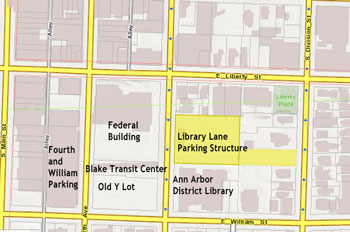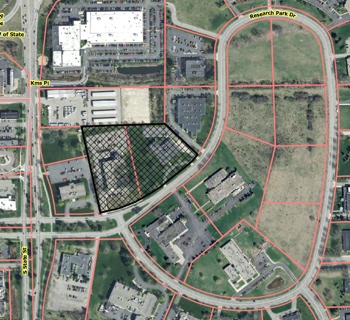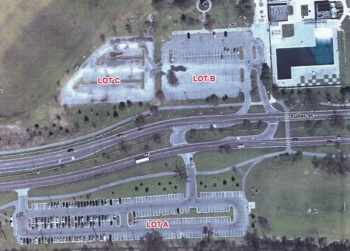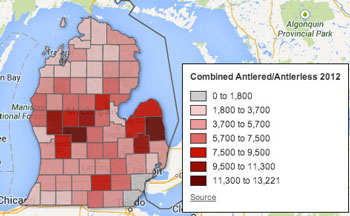Liberty Plaza was the focus of two items that appeared on the Aug. 19, 2014 agenda for the Ann Arbor park advisory commission: (1) extension of a fee waiver for events held at Liberty Plaza; and (2) feedback in response to city council action, which addressed Liberty Plaza and the potential park atop the Library Lane underground parking structure.

The surface of the Library Lane parking structure is highlighted in yellow. The city council has designated 12,000 square feet of that lot, on the west side along the South Fifth Avenue, as a future park.
Regarding feedback on Liberty Plaza and Library Lane, PAC unanimously passed a resolution to form a subcommittee to study issues related to those urban parks, and to allocate or obtain resources to oversee programming there for up to a year. Based on that effort, the subcommittee would analyze the outcome and deliver recommendations to council next year – no later than October 2015. This resolution, drafted by PAC chair Ingrid Ault and vice chair Graydon Krapohl, had been emailed to commissioners earlier in the day but was not available to the public prior to the meeting. [.pdf of Aug. 19, 2014 Liberty Plaza resolution]
Regarding the fee waiver, PAC voted unanimously to extend the waiver through October 2015 – coordinating with the subcommittee work on Liberty Plaza and Library Lane.
Both Aug. 19 items – the feedback to city council (but with no accompanying resolution) and fee waiver – had originally appeared on PAC’s July 15, 2014 agenda, but were postponed because three commissioners were absent at that meeting.
Liberty Plaza: Feedback to City Council
After July 15, PAC called a special meeting for Aug. 5 to begin their discussion on providing feedback to the city council on Liberty Plaza. Commissioners continued that discussion on Aug. 19, focused on PAC’s newly crafted resolution. It responded to a city council resolution that had been considered at the council’s June 16, 2014 meeting. That council resolution had been brought forward by Christopher Taylor (Ward 3) – who serves as an ex officio member of PAC – as well as mayor John Hieftje, Margie Teall (Ward 4) and Sabra Briere (Ward 1).
The original version of Taylor’s resolution would have directed the city administrator to “work collaboratively with the property owners adjacent to and near Liberty Plaza, the general public, PAC [park advisory commission], the Ann Arbor District Library, and the DDA to develop a conceptual design for an improved Liberty Plaza…”
But after nearly an hour of debate on June 16, the council voted to refer the resolution to PAC instead of approving it. The vote on referral to PAC came amid deliberation on some amendments to the resolution proposed by Jane Lumm (Ward 2) that would have broadened the scope of the effort to include the Library Lane lot. [.pdf of Lumm's amendments]
Funding for the collaborative work on the redesign, in the amount of $23,577, was specified in the proposed resolution as coming from the parks and recreation budget. In addition to a concept for a “re-imagined Liberty Plaza,” the resolution was supposed to result in options for funding construction, to be provided by city staff. Taylor’s resolution called for a report to be provided to the park advisory commission by December 2014 and to the city council a month later in January 2015.
Taylor’s resolution came in the context of a push by some Ann Arbor residents – including members of the Library Green Conservancy – to establish public park space on top of the underground Library Lane parking garage, which is southwest of Liberty Plaza separated from that park by a surface parking lot owned by First Martin Corp.
Related to that, the council voted at its April 7, 2014 meeting – as part of reconsidering a vote it had taken at its previous meeting on March 17 – to designate a 12,000-square-foot portion of the Library Lane surface to be reserved as an urban park. The result of the reconsidered resolution on April 7 undid the council’s earlier decision to establish a square foot range for the urban plaza – from 6,500-12,000 square feet. That April 7 council decision was made on a 7-4 vote, with dissent from Christopher Taylor (Ward 3), mayor John Hieftje, Margie Teall (Ward 4) and Chuck Warpehoski (Ward 5).
Deliberations among councilmembers on June 16, 2014 included questions about why PAC hadn’t been consulted on the resolution on Liberty Plaza. Taylor indicated that it wasn’t necessary to consult PAC, as it’s the council’s prerogative to set policy. The day after the council met, PAC’s regular monthly meeting, on June 17, was canceled.
PAC had previously been directed by the council to develop a set of recommendations regarding downtown parks, which were completed last year. The council accepted PAC’s recommendations at its Nov. 7, 2013 meeting. [.pdf of 21-page PAC downtown parks report]
PAC’s discussion on Aug. 19 was informed in part by a packet of material provided to commissioners at their Aug. 5 special meeting, which The Chronicle was not able to attend, because it was the date of primary elections. [.pdf of Aug. 5 Liberty Plaza packet] The materials included a memo with background and a bulleted list of issues related to Liberty Plaza, a list of potential ideas to address these issues, and suggestions for next steps.
Also included were PAC’s downtown parks recommendations, and a summary of previous work related to downtown parks, such as results from surveys conducted by the Ann Arbor Downtown Development Authority’s Connecting William Street study and by PAC’s downtown parks subcommittee. It also included case studies from downtown parks in four other communities: Director Park in Portland, Oregon; Arcadia Creek Festival Place in Kalamazoo; Campus Marius Park in Detroit; and Katz Plaza in Pittsburgh.
The Aug. 19 discussion also included comments from Matthew Altruda, who programs the Bank of Ann Arbor’s Sonic Lunch weekly summer concert series at Liberty Plaza. Ault had invited Altruda to the meeting to describe that effort, which is widely cited as a successful use of Liberty Plaza.
The resolution drafted by Ault recommended that the city allocate or obtain resources to oversee programming of Liberty Plaza and Library Lane for up to one year, in order to answer the following questions:
Determine costs for ongoing dedicated resources (human, material and financial) for programming of the spaces for one year, recognizing that a key element for success of any urban park is sustained and meaningful programming of the space.
Determine the success of programming efforts and how the currently designed spaces function in support of that programming. What worked and didn’t work?
Determine at the end of the study if issues long associated with Liberty Plaza are a function of design or the absence of sustained and meaningful programming, or a combination of both.
If shortcomings are design-related, does it warrant a partial or complete redesign based on the outcomes of the study?
Determine what role adjacent and nearby properties (public and private) have along with other downtown neighbors with regard to Liberty Plaza in determining key stakeholders for ongoing discussions.
The resolution will be forwarded to the city council for consideration.
Liberty Plaza: Fee Waiver
Also on Aug. 19, commissioners unanimously approved an extension of the Liberty Plaza fee waiver through October 2015 – a date coordinated with the subcommittee’s work on Liberty Plaza.
By way of background, a year ago the city council voted to waive fees for use of Liberty Plaza, located at Liberty and Divisions streets. The waiver was for a one-year trial period, through July 1, 2014.
The waiver had been recommended by PAC at its June 18, 2013 meeting. It came in response to a situation that arose earlier that spring when city staff applied fees to the hosting of Pizza in the Park in Liberty Plaza – a homelessness outreach ministry of a local church.
The goal of the waiver was to attract additional musicians, performers, and other events at Liberty Plaza.” A key “whereas” clause of the 2013 council resolution stated: “… it is the goal of PAC to further activate Liberty Plaza by increasing social, cultural, and recreational activities that take place there; …”
Later in the year, on Nov. 18, 2013, the council approved ordinance revisions to allow for a waiver of fees when an organization uses any park to distribute goods for basic human needs. The ordinance was revised to include the following text: “There shall be no park rental fee charged in association with a permit, where the permitted event’s primary proposed activity is the charitable distribution of goods for basic human needs.”
This brief was filed from the second floor council chambers at city hall, 301 E. Huron. A more detailed report will follow.














